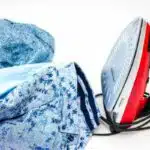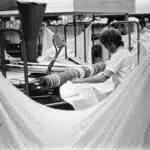Linen clothing is a popular choice for its lightweight and breathable nature, making it ideal for summer wear. However, the delicate fabric requires careful attention when it comes to ironing to maintain its crisp appearance. As a textile care expert, I have seen many people struggle with ironing linen clothing, often resulting in damage to the fabric or an unsatisfactory finish.
Ironing linen clothing can be challenging due to the fabric’s tendency to wrinkle easily. This article aims to provide you with the best way to iron linen clothes that will not only ensure a smooth finish but also preserve the fabric’s quality. By following our expert tips and techniques, you can confidently tackle your pile of linen clothes and impress your friends and family with perfectly pressed garments.
Understanding Linen Fabric
Linen clothing is a popular choice for many individuals due to its breathability, durability, and ability to keep the wearer cool in hot weather. However, linen care requires special attention to maintain its properties. Understanding the fabric properties of linen is essential for proper care and maintenance.
Linen is a natural fiber that comes from the flax plant. It has a unique texture and drape that gives it a characteristic appearance. Linen fibers are long and strong but also prone to wrinkling. Additionally, this fabric is absorbent and can hold up to 20% of its weight in moisture without feeling damp.
To care for your linen clothing properly, it’s important to know its specific fabric properties. The natural fibers of linen can become brittle when exposed to direct sunlight or heat, so it’s best to avoid drying your linen clothes in direct sunlight or using high heat settings on your dryer. In addition, ironing can be tricky with linen due to its tendency to wrinkle easily. A few tips and tricks can help you properly prepare your linen clothing before ironing it.
Preparing Your Linen Clothing For Ironing
Sorting linen clothing prior to ironing is essential for achieving the best results. Separate light and dark items, as well as delicate and sturdy ones.
Pre-treating linen clothing is recommended for removing spots and stains. Spot clean with a damp cloth before ironing.
To soften wrinkles, use a handheld steamer or hang the garment and spray with water before ironing.
Linen can be ironed on a low setting to prevent scorching. Use a pressing cloth or brown paper to protect the fabric.
Ironing linen clothing should be done in sections, starting with the neckband, then the yoke, sleeve plackets, and cuffs, and finally the body of the garment.
After ironing, hang the garment to cool and allow the fibers to settle. This will help the garment to keep its shape.
Sorting
Sorting is an essential step in preparing your linen clothing for ironing. It enables you to separate different types of fabrics and colors that may require different ironing temperatures and methods. Before sorting, ensure that all the clothes are clean and dry. Start by grouping the items according to their fabric types: pure linen, cotton-linen blends, or linen blends with synthetic fibers. This way, you can adjust the iron temperature and steam settings accordingly to avoid damaging the fabric.
Another important aspect of sorting is color separation. Linen clothes come in various shades, and some colors are prone to bleeding or fading when washed or ironed improperly. Sort them into light, dark, or bright-colored groups before ironing them. This way, you can prevent color transfer from one item to another during the ironing process. Additionally, sort out any clothes with stains for pre-treatment before washing and ironing.
Once you have sorted your linen clothes by fabric type and color shade, it’s crucial to store them correctly before ironing day arrives. Avoid cramming them together in a drawer or closet as this may cause wrinkles and creases that will be difficult to remove during ironing. Instead, hang them on hangers or fold them neatly on shelves to maintain their shape until it’s time for ironing. Properly storing your linen garments ensures they remain wrinkle-free and reduces the amount of time needed for pressing during the actual ironing process.
Pre-Treating
As a textile care expert, preparing your linen clothing for ironing involves several essential steps, including sorting by fabric type and color shade. However, another crucial aspect of preparation is pre-treating any stains on the garments before washing and ironing them. Pre-treatment involves using steam to remove stubborn stains or spots that may be difficult to remove during regular washing.
Using steam as a pre-ironing treatment is an effective way to remove stains from linen clothes. Steam helps to loosen dirt and grime from the fabric fibers, making it easier to remove during washing or ironing. To pre-treat with steam, hold the stained area above boiling water and allow the steam to penetrate the fibers for a few minutes. Then use a clean cloth to blot away any dirt or residue.
Pre-treating your linen garments before washing and ironing can extend their lifespan and maintain their appearance. By removing stains beforehand, you can avoid damaging the fabrics during washing or ironing processes. Therefore, it’s essential always to inspect your linen clothes for stains before cleaning them. With proper pre-treatment, you can achieve better results when ironing your linen garments while reducing the amount of time needed for pressing during the actual ironing process.
Steaming
As a textile care expert, it’s crucial to prepare your linen clothing correctly before ironing. One effective way to do this is by using steam as a pre-treatment method. Steaming can help remove stubborn stains and dirt from the fabric fibers, making it easier to wash and iron later.
Steaming has several advantages compared to other pre-treatment methods. It’s gentle on delicate fabrics like linen, preventing them from getting damaged during the cleaning process. Additionally, steaming doesn’t require any harsh chemicals or detergents that may cause discoloration or weaken the fibers of the garment. However, one disadvantage of steaming is that it may not be as effective in removing tough stains compared to other pre-treatment methods.
To steam your linen clothing effectively, hold the stained area above boiling water and allow the steam to penetrate for a few minutes. Afterward, use a clean cloth to blot away any residue or dirt remaining on the fabric. By pre-treating your linen garments with steam before washing and ironing them, you’ll maintain their appearance and extend their lifespan while reducing the amount of time needed for pressing during actual ironing.
Choosing The Right Iron And Ironing Board
After preparing your linen clothing for ironing, it’s time to choose the right iron and ironing board. This step is crucial in ensuring that your linen garments come out looking their best. When selecting an iron, consider its size, weight, and heat settings. Additionally, keep in mind that choosing the right ironing board is just as important as selecting the right iron.
Choosing ironing accessories can be overwhelming, but it doesn’t have to be. Start by assessing your needs and preferences. If you’re short on space, opt for a small or tabletop ironing board. On the other hand, if you have ample space or frequently launder large items such as sheets or curtains, invest in a full-size ironing board. Additionally, ensure that your chosen board has ample padding to prevent creasing and wrinkling.
Proper maintenance of irons is crucial to prolong their lifespan and maintain their functionality. Keep your iron clean by wiping it down after each use with a damp cloth and regularly descaling it with a mixture of water and vinegar or lemon juice. Avoid using tap water in irons as minerals can build up over time and cause clogging in the steam vents. Lastly, store your iron in an upright position to prevent leakage and damage.
Transition: Now that you’ve chosen the right tools for the job let’s dive into adjusting your iron’s settings for optimal results.
Adjusting Your Iron’s Settings
To properly iron linen clothing, it is important to adjust your iron’s settings accordingly. Linen is a delicate fabric that requires careful handling, and using the right amount of heat and steam is crucial. You should always use the lowest heat setting possible when ironing linen, as high heat can cause damage to the fabric.
When ironing delicate linen fabrics, it is best to use a lower steam setting or no steam at all. This will prevent water droplets from forming on the fabric and potentially leaving marks or stains. If you choose to use steam, make sure you do not saturate the fabric with too much moisture.
Adjusting your iron’s settings for linen clothing may take some trial and error, but with practice, you will find the perfect temperature and steam level for each item of clothing. By taking these precautions, you can ensure that your linen garments are perfectly pressed without damaging the delicate fibers.
Moving forward, using a linen spray or starch can enhance the appearance of your freshly pressed linen clothing. These products add an extra level of crispness and freshness to your garments, making them look their best. However, it is important to note that using too much spray or starch can cause buildup on your clothes over time. In the next section, we will discuss how to properly use these products without causing damage to your clothing.
Using A Linen Spray Or Starch
1.When applying linen spray or starch to linen clothing, it is important to ensure that the product is evenly distributed and that it does not leave any residue. 2.Using a linen spray or starch can help to reduce wrinkles and give linen clothing a crisper, more professional look. 3.Linen sprays and starches can also help to protect linen clothing from dirt and stains, making it easier to clean. 4.In addition, the use of these products can extend the life of linen clothing by preventing fraying and fading due to frequent washing.
Proper Application
As a textile care expert, one of the most important aspects of understanding linen care is knowing how to properly apply a linen spray or starch. Linen clothing can easily wrinkle and lose its shape, but with the right products and techniques, you can achieve a crisp and polished look.
One common mistake people make when using a linen spray or starch is not following the instructions on the label. It’s crucial to read and understand the proper application method for each product before use. Some sprays require you to apply them directly onto the fabric while others need to be diluted with water first. Similarly, some starches work best when applied before ironing while others should be added during the ironing process. By taking time to understand these differences, you’ll avoid damaging your linen clothes.
Another important factor in proper application is determining the right amount of product to use. Overusing sprays or starches can lead to stiff and crunchy clothing while underusing them may not provide enough hold for wrinkles. Start by applying a small amount of product at first and gradually increase if needed until you reach your desired level of crispness. Remember that less is often more when it comes to linen care.
In conclusion, using a linen spray or starch is an effective way to keep your linen clothing looking its best. By understanding linen care and avoiding common mistakes such as improper application or overuse of products, you can achieve a polished and professional look that will last throughout the day. Whether for work or special occasions, properly cared-for linen clothing always makes an impression!
Benefits Of Use
Understanding the benefits of using a linen spray or starch is crucial in maintaining the quality and appearance of your linen clothing. One of the primary benefits is that these products help keep wrinkles at bay, ensuring that your clothes look polished and professional throughout the day. Additionally, linen sprays and starches can add structure to garments that may have lost their shape due to washing or wear. This added support helps maintain the garment’s original silhouette, making it look fresh and new.
Another significant benefit of using a linen spray or starch is that it can prolong the life of your clothing. By helping to prevent wrinkles and maintain structure, these products can reduce stress on the fabric fibers, which ultimately results in less wear and tear. Additionally, properly cared-for linen clothing tends to last longer than poorly maintained pieces, making it a worthwhile investment for those looking to build a long-lasting wardrobe.
To maximize the benefits of using a linen spray or starch, it’s essential to follow proper maintenance tips. For instance, it’s crucial to launder your linen clothing correctly before applying any product to ensure that dirt and grime do not become trapped under the spray or starch. It’s also important to store your garments properly when not in use; this means avoiding plastic bags that trap moisture and instead opting for breathable storage options like cotton garment bags. By following these tips and incorporating a linen spray or starch into your care routine, you’ll be able to enjoy all of its benefits for years to come.
Ironing The Collar And Cuffs
As the saying goes, “the devil is in the details,” and this couldn’t be truer when it comes to ironing linen clothing. While many people may think that ironing a collar and cuffs is a simple task, it requires specific techniques to achieve a polished look. Here are some tips to help you master the art of ironing these essential parts of your linen clothing.
Firstly, start by ironing the underside of the collar and cuffs. This will help to prevent any visible creases from forming on the right side of the fabric. Use a hot iron and apply pressure while ironing in one direction, making sure not to linger too long in any one spot. When finished with the underside, flip over and repeat on the right side.
One common mistake people make when ironing collars and cuffs is failing to use enough steam. Linen can be tough to get perfectly smooth, but steaming can help soften the fibers and make them easier to work with. Use a spray bottle or your iron’s steam function regularly throughout the process. Additionally, don’t forget about pressing seams and corners for a crisp finish.
Now that you have mastered ironing collars and cuffs let’s move on to sleeves. The key here is to avoid creating creases at all costs! Start by laying out each sleeve flat on your board with its seam facing upwards. Begin at the cuff end of your sleeve, working your way up towards where it joins onto your shirt body. Remember not to linger too long in any one spot! With these techniques, you’ll be able to give your linen shirts an expert touch every time you wear them for any occasion!
Ironing The Sleeves
When ironing linen clothing, it is essential to give extra attention to the sleeves. Linen shirt sleeves come in different lengths, from short sleeves to long sleeves. The length of the sleeves can affect the ironing technique used. Therefore, it is crucial to consider the sleeve length before beginning the ironing process.
To start, ensure that your iron is set at the correct temperature recommended for linen fabric. Place the sleeve on your ironing board with its seam facing up. Start by pressing out any wrinkles present on the shoulder area of the sleeve using a back and forth motion with your iron. Slowly move down towards the cuff of the sleeve, applying light pressure as you go along.
Once you reach the cuff area, use a horizontal motion with your iron while holding onto each side of the cuff’s opening to keep it flat. Afterward, flip over with one side of the sleeve still on top of your board and complete this process for that side’s shoulder and cuff area before repeating on another side’s shoulder and cuff area. By mastering this technique, you’ll be able to achieve wrinkle-free sleeves every time without damaging or stretching them. In our next section, we will discuss how to efficiently iron both sides of a shirt without leaving any creases behind.
Ironing The Back And Front Of The Shirt
- The temperature of the iron should be adjusted according to the fabric of the shirt; for linen clothing, the temperature should be set to the highest setting that the fabric can safely withstand.
- To avoid scorching the fabric, it is important to use a steady stream of water from a spray bottle while ironing.
- To ensure that both the front and the back of the shirt are ironed evenly, the iron should be placed perpendicular to the fabric and moved in a back-and-forth motion.
- To reduce the risk of wrinkles and creases, ironing should begin on the inside of the shirt and move outward.
- Working in small sections and pressing firmly will help to eliminate any remaining wrinkles and creases.
- Once the ironing is complete, the fabric should be allowed to cool before being folded or hung.
Temperature
Ironing linen clothing can be a daunting task, but with the proper ironing technique, it can be done with ease. One of the most important factors to consider when ironing linen shirts is the temperature setting on your iron. Linen is a delicate fabric that requires a specific temperature range to avoid damaging it.
To ensure you are using the proper temperature while ironing your linen shirt, check the label for any specific instructions. Most linen shirts require a low to medium heat setting. Using high heat can cause irreversible damage to the fabric, such as scorch marks or shrinkage. It’s also important to allow your iron time to heat up before use, as this will help maintain a consistent temperature throughout the ironing process.
One of the most common mistakes people make when ironing linen shirts is leaving them damp or wet before starting. This can cause wrinkles and make it more difficult to achieve a crisp finish. To avoid this mistake, ensure your shirt is completely dry before beginning to iron. Remember that patience is key when ironing linen clothing – take your time and work in small sections for best results. By following these guidelines for proper temperature control and avoiding common mistakes, you’ll be able to create perfectly pressed linen shirts every time without causing any damage!
Water
Ironing the back and front of a shirt is an essential part of maintaining its appearance. However, it’s important to note that proper ironing techniques go beyond just pressing the fabric with heat. The use of water can also play a crucial role in achieving a crisp finish. As a textile care expert, I recommend using distilled water for ironing linen shirts to avoid any mineral buildup that can cause staining or damage to the fabric.
In addition to using distilled water, it’s important to consider the temperature of the water used during the ironing process. Cold or lukewarm water is ideal for dampening the fabric before ironing, as hot water can cause shrinkage or even scorch marks on delicate fabrics like linen. It’s also important to avoid soaking the fabric in water for too long, as this can cause unwanted wrinkles and make it more difficult to achieve a smooth finish.
When using water during the ironing process, it’s important to remember that less is often more. A light misting of cold or lukewarm distilled water onto areas that need extra attention can help loosen stubborn wrinkles and make them easier to press out with your iron. However, be sure not to saturate the fabric with too much moisture, as this can lead to unwanted puckering or stretching. By incorporating these tips for using distilled water and controlling its temperature when ironing your linen shirts, you’ll be able to achieve professional-looking results every time!
Iron Position
Proper ironing techniques are essential in maintaining the appearance of your shirt. However, it’s not uncommon to make mistakes during the process, such as using the wrong temperature or failing to position the iron correctly. As a textile care expert, it’s important to educate people on how to avoid these common mistakes and achieve the best results possible.
One aspect of proper ironing technique is understanding the different positions of the iron and their effects on the fabric. When ironing the back and front of a shirt, it’s important to start with the collar and work downwards in sections. For each section, position the iron vertically and press down firmly without dragging it across the fabric. This helps to remove any wrinkles without causing any additional creases or damage.
Another important consideration is adjusting the heat setting based on the type of fabric being ironed. For delicate fabrics like linen, use a low heat setting to avoid scorch marks or shrinkage. When using higher temperatures for thicker fabrics like cotton or wool, be sure to move quickly and avoid leaving the iron in one spot for too long. By understanding these different iron positions and heat settings, you can achieve a crisp finish without damaging your shirt.
In conclusion, proper ironing techniques go beyond just applying heat to your shirt. Understanding different iron positions and heat settings can help you achieve professional-looking results while avoiding common mistakes that can cause damage or unwanted creases. As a textile care expert, my goal is to empower people with knowledge so they can confidently care for their clothing and extend its lifespan.
Ironing Pants Or Skirts
When it comes to ironing pants or skirts, it’s important to take into consideration the fabric type. While linen clothing requires a certain technique, pants and skirts made of cotton or polyester may need different care instructions.
Firstly, choose the appropriate accessories for your ironing session. A reliable iron with adjustable temperature settings is essential for efficient and safe ironing. Additionally, a pressing cloth can help protect delicate fabrics from direct heat exposure. Make sure that your ironing board is clean and sturdy before use.
To achieve crease-free results when ironing pants or skirts, start with the waistband, then move on to the pockets and seams. When working on the legs, begin at the top and work downwards towards the hemline. A tip to achieve sharp creases in dress pants is to fold along the crease line while damp, secure with clips or pins, then press with a hot iron until dry.
Choosing accessories and following these tips can make all the difference in achieving professional-looking ironed pants or skirts. However, sometimes tough wrinkles may persist despite our best efforts. In this case, there are additional steps you can take to tackle these stubborn wrinkles effectively.
Nested bullet point list:
- Accessories:
- Reliable Iron
- Pressing Cloth
- Clean & Sturdy Ironing Board
- Tips for Crease-Free Results:
- Start with Waistband
- Move onto Pockets & Seams
- Work on Legs from Top Downwards
- Use Clips/Pins for Sharp Creases
Transition sentence: Now that we’ve covered some general tips for ironing pants and skirts, let’s dive into dealing with tough wrinkles and how to remove them effectively.
Dealing With Tough Wrinkles
The days of the flat iron are long gone. Today, we have steam and dry irons that offer more efficient and effective ways to get rid of wrinkles. When it comes to ironing linen clothing, choosing the right method can make all the difference. Steam irons are recommended as they use moisture to loosen up tough wrinkles better than dry irons.
To avoid damaging your delicate linen fabrics while ironing, there are a few techniques you should keep in mind. First, always start with a low temperature setting and gradually increase it until you achieve the desired result. Secondly, use a pressing cloth to protect the fabric from direct heat. Finally, never leave your iron on one spot for too long as this can cause scorch marks on the fabric.
By following these tips, you can easily iron your linen clothing without damaging or ruining them. In the subsequent section, we will delve into some other measures you can take to avoid damage to your linen clothing during washing and storage.
Avoiding Damage To Your Linen Clothing
Dealing with tough wrinkles is just one aspect of caring for your linen clothing. Another important consideration is how to prevent shrinkage and avoid discoloration. By taking the right steps, you can extend the lifespan of your linen garments while keeping them looking their best.
To prevent shrinkage, it’s critical to follow the washing instructions on the care label. Linen can be damaged by high temperatures, so always wash in cool or lukewarm water. Additionally, avoid using bleach or fabric softener, as these products can weaken fibers and cause shrinking. If possible, air-dry your linen clothing rather than putting it in the dryer.
Another issue to watch out for when caring for linen clothing is discoloration. This can occur due to exposure to sunlight or improper storage methods. When washing your garments, use a mild detergent that won’t cause colors to bleed or fade. Store your clothing in a cool, dry place away from direct sunlight to prevent fading and discoloration over time.
As you work to care for your linen wardrobe, remember that proper maintenance involves more than just dealing with wrinkles. Take steps to prevent shrinking and discoloration by following washing instructions carefully and storing garments properly. With these tips in mind, you’ll be able to enjoy your favorite linen pieces for years to come! In the next section, we’ll look at some best practices for storing your linen clothing between wears and seasons.
Storing Your Linen Clothing
To ensure that your linen clothing stays in pristine condition, it is important to properly store them. Storing linen clothing can be simple if you follow these easy steps. First, make sure to clean and dry your linen clothing before storing them. This will prevent any dirt or moisture from settling into the fabric and causing damage.
Once your linen clothing is clean and dry, fold them neatly and place them in a cool and dry place. Avoid storing them in direct sunlight or near any sources of heat as this can cause the fabric to fade or become discolored. Additionally, avoid hanging linen clothing for long periods of time as this can cause stretching and distortion of the fabric.
Proper storage of linen clothing is essential in maintaining the quality of the fabric over time. To ensure that your linen clothing remains in great condition for years to come, consider these helpful tips:
- Store your linen clothing in a breathable container such as a cotton bag or wrapped in acid-free tissue paper.
- Avoid using plastic bags or covers as they trap moisture which can lead to mold growth.
- Use lavender sachets or cedar blocks to deter moths and other insects from damaging your linen clothing.
- Rotate your stored items every few months to prevent creases from becoming permanent.
By following these simple tips for storing linen clothing, you can prolong the life of your garments and keep them looking their best. In addition to proper storage techniques, there are other care tips for maintaining the quality of your beloved linen clothes that we will discuss in the next section.
Other Care Tips For Linen Clothing
Linen should be stored in a cool, dry place and hung on a sturdy hanger. It is best to avoid folding linen garments as this can cause permanent creasing. To avoid shrinkage, linen should be washed in cold water and laid flat to dry. Ironing linen should be done at a low temperature with a damp cloth between the fabric and the iron to prevent scorching.
Storing Linen
When it comes to linen clothing, proper care is essential to maintain its quality and longevity. While ironing is an important aspect of caring for linen garments, proper storage is equally crucial. For instance, folding techniques can make a significant difference in how well your linen clothes hold up over time.
One of the most important things to consider when storing linen clothing is the season. During the summer months, it’s best to store your linen clothes in a cool and dry place. On the other hand, during the winter months, you’ll want to keep them in a warm and dry location. This will help prevent any moisture from accumulating on your clothes and causing damage.
When folding linen clothes for storage, it’s important to be gentle and avoid creasing or wrinkling them as much as possible. One technique that works well is to fold each garment neatly and then stack them on top of each other in a drawer or on a shelf. You may also consider using acid-free tissue paper between each piece of clothing to further protect them from damage. By following these simple tips, you can ensure that your linen clothing stays looking great for years to come!
Avoiding Shrinkage
Linen clothing is a popular choice for many due to its breathability and durability. However, proper care is essential to maintain its quality and avoid shrinkage. Shrinkage can occur when linen garments are exposed to heat or moisture during washing or drying.
To prevent shrinkage, it’s important to follow some tips for washing linen clothing. First, always read the care label and follow the manufacturer’s instructions carefully. Use mild detergent and avoid using bleach or fabric softener as they can damage the fabric. When washing, use cold water on a gentle cycle and avoid overcrowding the machine.
Best practices for washing linen clothing also include air drying instead of using a dryer. If you must use a dryer, opt for low heat and remove the clothes promptly once they’re dry. Avoid over-drying as it can cause shrinkage in linen fabrics. By following these tips, you can ensure that your linen garments stay looking great while maintaining their shape and size.
Troubleshooting Common Ironing Problems
Other Care Tips for Linen Clothing provided guidelines on how to properly care for your linen clothing, including washing and drying. However, ironing is the final step to achieving a professional-looking finish for your linen garment. In this section, we will discuss Troubleshooting Common Ironing Problems.
One of the issues that may arise during ironing is uneven heat distribution. This can result in wrinkled or burnt areas on your linen garment. To avoid this problem, make sure to set the iron temperature according to the fabric care label. Use a pressing cloth when ironing delicate fabrics or garments with embellishments. Additionally, ensure that the iron plate is clean and free from any residue or debris that could affect its performance.
Another common issue during ironing is water spots. These can occur when using steam or spraying water directly onto the fabric. To prevent water spots, use distilled water in your iron instead of tap water. Alternatively, you can fill a spray bottle with distilled water and mist it over the garment before ironing. Be sure to use only enough moisture to remove wrinkles without saturating the fabric.
Aside from these ironing issues, there are also common linen fabric problems such as shrinking and color fading. Avoid shrinking by following the manufacturer’s care instructions and washing in cold water using a gentle detergent. Prevent color fading by washing garments inside out and avoiding direct sunlight when air-drying or line-drying.
To achieve a professional-looking finish for your linen garment, it is important to address any potential issues during the ironing process while also being mindful of common linen fabric problems such as shrinking and color fading. By following these guidelines, you can prolong the life of your linen clothing while keeping them looking their best.
Achieving A Professional-Looking Finish
Achieving a professional-looking finish when ironing linen clothing is the hallmark of an expert textile care specialist. It requires patience, attention to detail, and precision in handling the fabric. Ironing linen clothing can be an enjoyable experience if you follow some simple tips and avoid common mistakes.
One of the most common mistakes beginners make when ironing linen clothing is to apply too much pressure on the fabric. Linen is a delicate fabric that requires a gentle touch. Applying too much pressure can damage the fibers and leave unsightly creases. To avoid this mistake, use a light touch and let the weight of the iron do most of the work.
Another common mistake beginners make is not using enough steam or heat when ironing linen clothing. Linen has natural fibers that tend to wrinkle easily, so it needs plenty of moisture to smooth out wrinkles effectively. To achieve a professional-looking finish, use a high-temperature setting and apply steam liberally while ironing.
For beginners who want to achieve a professional-looking finish when ironing linen clothing, there are several tips to keep in mind. First, always start with clean and dry clothes. Second, avoid using too much starch as it can stiffen the fabric and make it difficult to iron correctly. Finally, invest in a good quality iron that heats up quickly and has adjustable temperature settings.
In summary, achieving a professional-looking finish when ironing linen clothing requires patience, attention to detail, and precision in handling the fabric. By avoiding common mistakes and following these tips for beginners, you can enjoy an enjoyable experience that results in perfectly pressed linen clothes without any unwanted creases or wrinkles.
Conclusion
Linen clothing is a popular choice for its comfort and breathability, but it can be challenging to maintain its crisp appearance. To ensure your linen clothing always looks its best, it’s essential to understand how to properly care for it. By following the steps outlined in this article, you’ll be able to confidently iron your linen garments without damaging the fabric.
Firstly, understanding linen fabric is crucial as it has unique properties that require special care when ironing. Secondly, preparing your linen clothing before ironing, choosing the right iron and ironing board, adjusting your iron’s settings correctly, and using a linen spray or starch can all help achieve a professional-looking finish. Additionally, storing your linen clothing correctly and following other care tips can prolong the life of your garments.
Despite these efforts, some may argue that taking such meticulous care of one’s clothes is too time-consuming and not worth the effort. However, investing time in caring for your clothes ultimately saves money by extending their lifespan and reducing the need for frequent replacements. Moreover, taking pride in our appearance through well-maintained clothes enhances our self-esteem and confidence. So let us embrace proper textile care techniques as an act of self-care and investment in ourselves.
Image Credits
- “Congolese Men Will Iron Clothes If It Pays” by Woody Collins (featured)





















![How To Wash And Care For White Clothes 21 The only genuine borax soap cleanses hygienically saves the clothes and hands. 20 Mule-Team brand Boraxo white laundry soap [front]](https://green-life.blog/wp-content/uploads/2023/05/YDXLLCovnOjq-150x150.jpg.webp)







